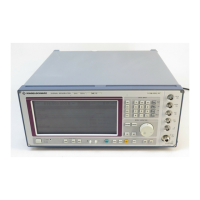SME Fast-Restore-Modus
1038.6002.02 3.143 E-13
3.9 Fast Restore Mode
The Fast Restore mode is available with SME03A and units that are equipped with option Fast CPU for
SMIQ SM-B50. Device settings can be saved and recalled very quickly via the IEC/IEEE bus using the
commands described below. 1000 memory locations are available.
In contrast to the SAVE/RECALL function, not the unit parameters but only the setting data of the
modules are stored in the Fast Restore mode. RESTORE by means of the ’:SYSTem:SREStore’ or ’!..’
command has an immediate effect on the module. The database (which stores all entries and delivers
the display data) is bypassed. This allows a very high setup speed.
Commands:
:SYSTem:SSAVe 1...1000
This command saves the current device setting at the memory location indicated.
:SYSTem:SREStore 1...1000
This command loads a device status that was stored using the :SYSTem:SSAVe command
(RESTORE). One of 1000 available memory locations is selected by entering a numeral.
! <least significant byte> <most significant byte>
This command has the same effect as the:SYSTem:SREStore command. The setting time
however is 300 µs less. It is optimized for highest speed and does not comply with the SCPI
syntax regulations. Exactly 3 bytes are transmitted including the '!' (which is the identifier of this
command). With the last byte, EOI has to be activated as delimiter.
The memory location is binary-coded in the 2 bytes indicated.
Example:
RESTORE at memory location 268 (-> 010C hex) corresponds to the following binary
command:
0010 0001 0000 1100 0000 0001
'!' hex 0C hex 01
Binary-coded bytes can usually not be written as printable ASCII characters.
When programmed in C, the above command has the following form:
char sendstring[3] = {'!', 0x0C, 0x01}
In BASIC, the command string to be output is as follows:
'!' + CHR$(12) + CHR$(1)
(The pros for CHR$ are decimal numbers, therefore 12 for 0C hex.)
Since binary-coded bytes may also have the value of the LF (line feed) character which is
interpreted as a delimiter, switch over to 'only EOI' as delimiter by selecting
':SYSTem:COMMunicate:GPIB:LTERminator EOI' prior to using this command.

